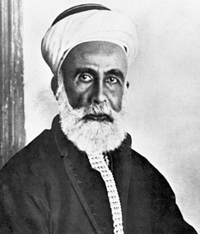
Arab Perspective
Arab subjects under the Sultanate
The approach of the Ottoman Empire to the Arab lands should be understood within the context of the empire’s preoccupation with its European frontiers. Throughout its existence, much of the resources and energy of the Ottoman Empire was dedicated to the expansion and defence of its boundaries in Central and Eastern Europe. Arab lands with their smaller population and revenue were always secondary to the European lands of the empire. Nevertheless, Arab lands possessed one thing that was of extreme importance to the empire. To legitimise their sovereignty in the Muslim world the Ottomans soon realised the significance of linking themselves to the holy places of Islam in Arabia and Palestine. That was done through patronage of Islamic pilgrimage to the holy places in Mecca and Medina and to Jerusalem. This “public act” of pilgrimage from two main centres, Damascus and Cairo, became an annual assertion of this Ottoman sovereignty. As the custodians, defenders and servants of the two sacred sanctuaries Ottoman sultans claimed supremacy in the Muslim world.
By 1552 all the Arab lands were under Ottoman rule except for Morocco, where the Sharifian Arab dynasties retained power from 1549 until 1912 when Morocco, after being caught up in two international crises in 1906 and 1912 between Germany and other European powers, became a joint French–Spanish protectorate.
The Ottoman Empire was one of the largest political structures since the great Islamic dynasties. It was centrally governed with a single administrative system achieved through the sultan’s appointing governors from Ottoman families or groups. With time, the grip of the central power was reduced and the local governments, although still faithful to the sultans, started to practise more autonomy, as happened in Egypt, Algeria and Tunisia.
Places in the Levant and west Arabia that were remote from Istanbul were largely neglected for at least 300 years. The only exception was the very thin strip of land along the pilgrimage route, which came to the foreground briefly once a year. For an annual payment, protection of the route was entrusted to the pastoral tribes along its length. As for other lands, it was enough for the Ottomans to give recognition to local families of lords, provided they collected and, most importantly, transmitted revenue from their territories. In the same way, chiefs of pastoral tribes of the Syrian Desert, Mesopotamia and west Arabia were given formal recognition. A policy of manipulation, setting tribe against tribe or families of the same tribe against one another, was usually sufficient to preserve the balance. Arab lands reappeared on the Ottoman radar from the second half of the 19th century when almost all the European provinces of the empire were lost and the danger of losing the Arab provinces became imminent, but it was too late to do anything.
Winds of change and shattered dreams
At the beginning of the 19th century, the first encounter with Europe (Napoleon’s campaign to Egypt and Syria) after a long interruption and fascination with its advanced technology and culture, especially with the ideals of the French Revolution, gave a resounding demonstration of European supremacy and provided a glimpse of a different, and perhaps better, way of life and thought. Arab intellectuals, not fully aware of potential threats from the Western powers, welcomed any developments and contacts with Europe that could help to lift Arabs from the depths into which their culture had sunk. The trajectory of Arab awakening went from Ottoman patriotism to Arab nationalism. It was only in the first two decades of the 20th century that the idea of nationalism became clear among Turks, Syrians, Egyptians and Tunisians. A number of national movements developed in answer to diverse challenges. Turkish nationalism led to the rise of Arab nationalism. Both were a reaction to the crumbling of the empire and the breakdown of the ideal of Ottoman patriotism. Encouraged by the United Kingdom and supported by Arab nationalist groups, in 1916 Husayn, the Sharif of Mecca, declared a revolt against the Ottoman sultan relying on promises from the United Kingdom to establish an Arab kingdom under Husayn’s leadership. Unfortunately, the Western powers did not keep the promises given to Sharif Husayn, and, through a series of secret agreements to divide the Arab lands among the Western powers including the Sykes–Picot Agreement of 1916, by 1921 the only parts of the Arab lands that remained free from European control were the inland areas of the Arabian Peninsula.
Mohammad Najjar, Amman
Historical Profiles: Egypt | Jordan | Lebanon | Qatar | Saudi Arabia | Tunisia | United Arab Emirates (Sharjah)
Political Context Timeline: Algeria | Egypt | Jordan | Lebanon | Morocco | Qatar | Saudi Arabia | Tunisia | United Arab Emirates (Sharjah)
Download
 As Word (text only)
As Word (text only)











